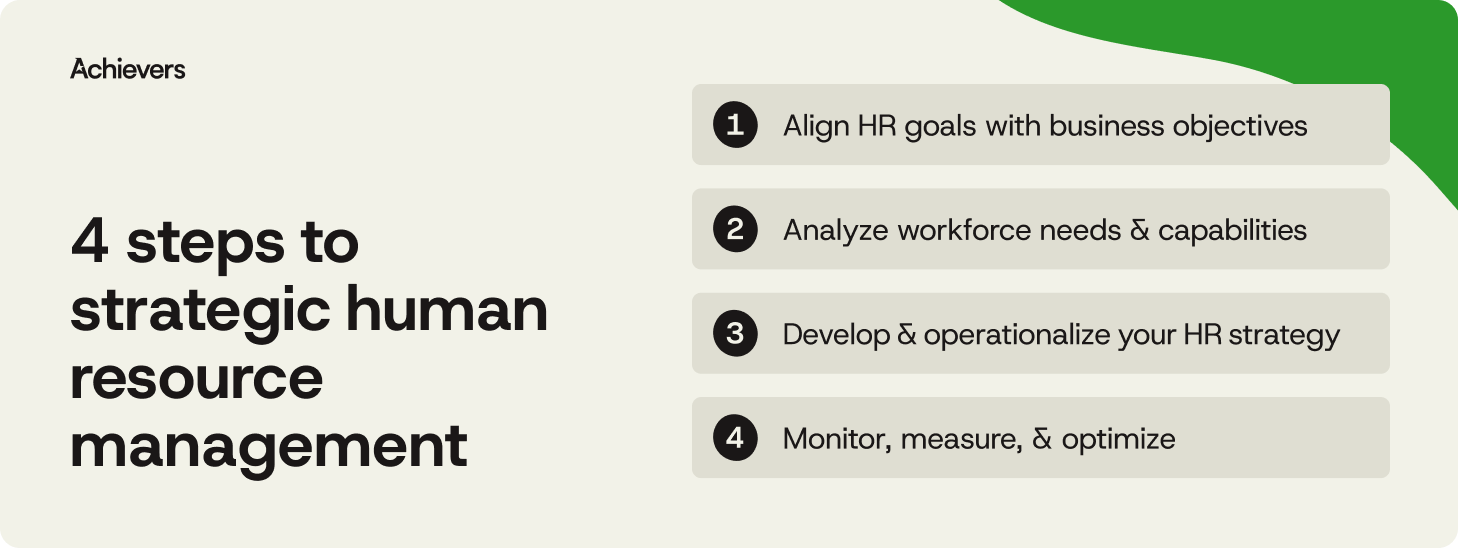Table of contents
Create a culture that means business™
Schedule a demo with an Achievers solution expert today.
Strategic human resource management might sound like something out of a business school textbook, but it’s really just smart, people-first leadership.
It’s how HR teams stop chasing problems and start setting the pace — aligning people strategies with business goals, shaping culture, and building teams that are ready for whatever’s next. And it’s more relevant than ever. Research from SHRM tells us that nearly half of HR professionals say improving the employee experience is a top priority this year. Because when the experience works, so does everything else — engagement, retention, performance, all of it.
In this guide, we’ll break down what strategic HRM actually looks like, how it’s different from the old-school playbook, and how to bring it to life in your organization.
What is strategic human resource management?
Strategic human resource management (SHRM) is HR with a plan — one that connects every people decision to a bigger business goal.
While traditional HR focuses on keeping things running — policies, compliance, paperwork — SHRM is about moving the business forward. It’s the shift from “let’s just get this posted and hired” to “how do we build a workforce that actually moves the needle?” SHRM treats employees as core to business success (not just headcount), and builds programs — think talent development, workforce planning, recognition — that support them in doing their best work.
4 steps to strategic human resource management
Strategic HR doesn’t need to be overwhelming — but it does need to be intentional. If you want your people strategy to drive business results (and not just live in a slide deck), start with these four steps:

Step 1: Align HR goals with business objectives
If your people programs aren’t tied to what the business is trying to achieve, it’s time for a reset. Strategic HR starts with alignment — making sure every initiative connects back to the big picture.
- Start by getting clear on what the business is aiming for — growth, retention, innovation, expansion.
- Then, map those priorities to people strategies: hiring plans, career development, recognition, and more.
- Use recognition to reinforce the behaviors that support company goals. When people see those moments celebrated, they know what “good” looks like — and they’ll bring more of it.
Step 2: Analyze workforce needs and capabilities
You can’t build the right strategy if you don’t know what you’re working with. This step is all about getting a clear picture of your current talent — and where the gaps are.
- Use surveys, feedback tools, and performance data to understand what your people need and how they’re doing.
- Run skills audits to spot capability gaps and areas for growth.
- Identify high-potential employees and future leaders so you can start planning ahead — not just reacting to turnover.
- Don’t just think about who you need now. Think about who you’ll need next year (and the year after that).
Step 3: Develop and operationalize your HR strategy
Now it’s time to take those goals and insights and turn them into real, actionable programs. This is where your strategy starts showing up in the day-to-day.
- Build programs that bring your values to life — from DEIB efforts to manager enablement to recognition that actually means something.
- Make sure your strategy shows up across the employee journey — not just in onboarding or reviews, but in the in-between moments too.
- Consistency is key. If your people strategy feels scattered, it won’t stick.
- Keep it flexible, scalable, and easy to use — because the best HR strategies are the ones employees actually notice and engage with.
Step 4: Monitor, measure, and optimize
The best strategies evolve. Once your programs are in place, keep a close eye on what’s working — and what’s not.
- Set KPIs that actually matter: recognition frequency, retention, engagement scores, productivity, DEIB outcomes.
- Use platform insights and dashboards to track progress and uncover patterns.
- Create regular check-ins and feedback loops so your people can help shape the path forward.
- Stay flexible. Strategy isn’t a one-and-done — it’s a living, breathing part of how you work.
Core pillars of strategic human resource management
Strategy doesn’t mean much if it doesn’t show up in the everyday. These pillars help you take big-picture goals and bring them to life — shaping behavior, building culture, and giving your workforce the tools to grow with you.
- Behavioral alignment: Values shouldn’t live on a poster — they should guide how work gets done. When you bake them into hiring, recognition, and performance, people know what matters. That clarity builds trust and helps everyone pull in the same direction, even as your business evolves.
- Recognition and rewards: Recognition isn’t just about saying “thanks.” It’s how you reinforce what good looks like. Companies using Achievers recognize 2x more often — and see up to 5x more impact on retention, engagement, and performance. Recognition that’s frequent and values-based doesn’t just feel good — it drives results.
- Data and insights: Great HR strategy runs on great intel. Real-time data helps you spot trends, fix gaps, and make faster decisions. With platforms like Achievers, you can track recognition activity, tie it to engagement and retention, and keep your people strategy grounded in what’s actually working.
- Talent development and mobility: People want to grow — and when you help them do it, they’re more likely to stick around. Strategic HR focuses on internal mobility, upskilling, and clear paths forward. When development is part of the plan, you build loyalty, agility, and a bench that’s ready for what’s next.
Why recognition is key to SHRM’s business impact
If your SHRM strategy doesn’t include recognition, you’re leaving results on the table. According to Achievers 2024 State of Recognition Report, only 30% of HR leaders using internal recognition programs see business impact — but that jumps to 60% with an online solution.
Here’s how that shows up:
- Engagement: Employees who feel recognized are more connected to their work and their team. Recognition helps them see how their efforts contribute to bigger goals — and that clarity boosts motivation.
- Retention: People are more likely to stay when they feel appreciated. Strategic recognition programs reinforce belonging, reduce workplace burnout, and help keep top talent from walking out the door.
- Productivity: Recognition builds momentum. When the right behaviors are acknowledged in real time, employees stay focused, aligned, and more likely to repeat what works.
- Innovation: A culture of recognition encourages psychological safety — which means people are more comfortable sharing ideas, taking risks, and driving change.
How Achievers brings strategic HR to life
It’s one thing to have a strategy — it’s another to make it stick. That’s where Achievers comes in.
Whether you’re rolling out a new recognition program or scaling your people strategy across teams and time zones, Achievers helps you turn strategic intent into everyday action. From reinforcing values to driving measurable results, here’s how the recognition platform supports SHRM in practice:
- Recognition that actually moves the needle: Employees using Achievers are recognized 2x more often than on other platforms — and that frequency pays off with up to 5x greater impact on engagement, retention, and productivity.
- A global rewards experience with local relevance: With 3M+ rewards, 2,500+ brands, and fulfillment in 190 countries, every recognition feels personal — whether your team’s remote, hybrid, or worldwide.
- Built into the tools your people already use: Achievers integrates with Microsoft Teams, Workday, Outlook, and more, so recognition happens in the flow of work — not after the fact.
- Real-time insights that fuel better decisions: Dashboards and reporting make it easy to track recognition trends, identify gaps, and tie your people strategy to business outcomes.
Strategic human resource management as your competitive edge
Let’s be honest — plenty of companies say they have a people strategy. But without the tools to bring it to life, even the best SHRM plans end up collecting dust.
Strategic human resource management gives you a real advantage — not just on paper, but in the way your people show up, stay engaged, and drive the business forward. When HR decisions are tied to goals, values, and daily behavior, you get more than alignment. You get momentum.
That’s where Achievers comes in.
With recognition built into everyday workflows, real-time feedback loops, and insights your whole team can act on — no analyst required. Achievers helps you move from intent to impact — without the annual strategy reset.



